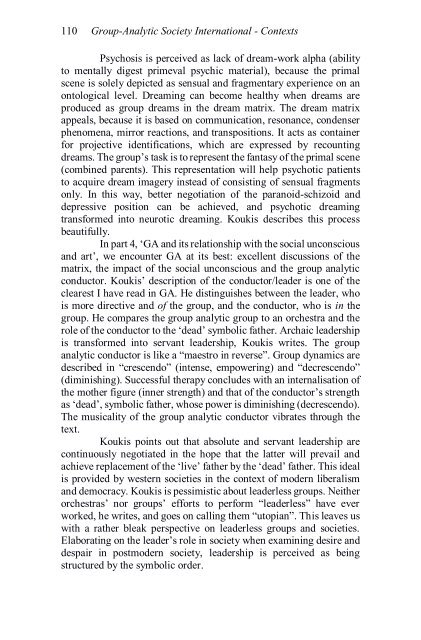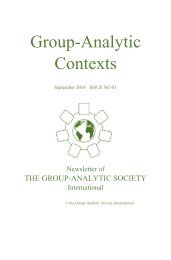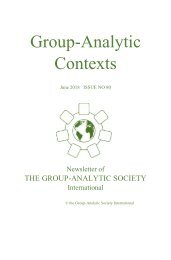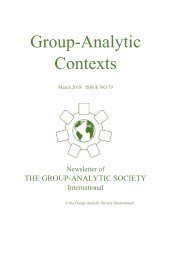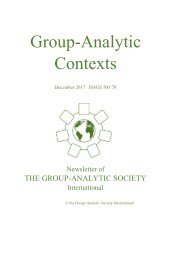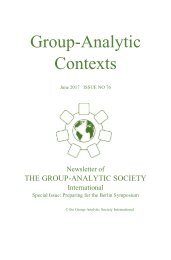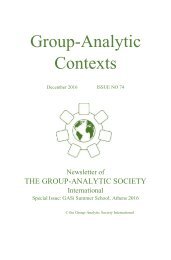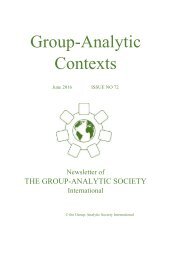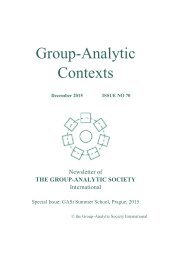Group Analytic Contexts, Issue 77, September 2017
Newsletter of the Group Analytic Society International
Newsletter of the Group Analytic Society International
You also want an ePaper? Increase the reach of your titles
YUMPU automatically turns print PDFs into web optimized ePapers that Google loves.
110 <strong>Group</strong>-<strong>Analytic</strong> Society International - <strong>Contexts</strong><br />
Psychosis is perceived as lack of dream-work alpha (ability<br />
to mentally digest primeval psychic material), because the primal<br />
scene is solely depicted as sensual and fragmentary experience on an<br />
ontological level. Dreaming can become healthy when dreams are<br />
produced as group dreams in the dream matrix. The dream matrix<br />
appeals, because it is based on communication, resonance, condenser<br />
phenomena, mirror reactions, and transpositions. It acts as container<br />
for projective identifications, which are expressed by recounting<br />
dreams. The group’s task is to represent the fantasy of the primal scene<br />
(combined parents). This representation will help psychotic patients<br />
to acquire dream imagery instead of consisting of sensual fragments<br />
only. In this way, better negotiation of the paranoid-schizoid and<br />
depressive position can be achieved, and psychotic dreaming<br />
transformed into neurotic dreaming. Koukis describes this process<br />
beautifully.<br />
In part 4, ‘GA and its relationship with the social unconscious<br />
and art’, we encounter GA at its best: excellent discussions of the<br />
matrix, the impact of the social unconscious and the group analytic<br />
conductor. Koukis’ description of the conductor/leader is one of the<br />
clearest I have read in GA. He distinguishes between the leader, who<br />
is more directive and of the group, and the conductor, who is in the<br />
group. He compares the group analytic group to an orchestra and the<br />
role of the conductor to the ‘dead’ symbolic father. Archaic leadership<br />
is transformed into servant leadership, Koukis writes. The group<br />
analytic conductor is like a “maestro in reverse”. <strong>Group</strong> dynamics are<br />
described in “crescendo” (intense, empowering) and “decrescendo”<br />
(diminishing). Successful therapy concludes with an internalisation of<br />
the mother figure (inner strength) and that of the conductor’s strength<br />
as ‘dead’, symbolic father, whose power is diminishing (decrescendo).<br />
The musicality of the group analytic conductor vibrates through the<br />
text.<br />
Koukis points out that absolute and servant leadership are<br />
continuously negotiated in the hope that the latter will prevail and<br />
achieve replacement of the ‘live’ father by the ‘dead’ father. This ideal<br />
is provided by western societies in the context of modern liberalism<br />
and democracy. Koukis is pessimistic about leaderless groups. Neither<br />
orchestras’ nor groups’ efforts to perform “leaderless” have ever<br />
worked, he writes, and goes on calling them “utopian”. This leaves us<br />
with a rather bleak perspective on leaderless groups and societies.<br />
Elaborating on the leader’s role in society when examining desire and<br />
despair in postmodern society, leadership is perceived as being<br />
structured by the symbolic order.


